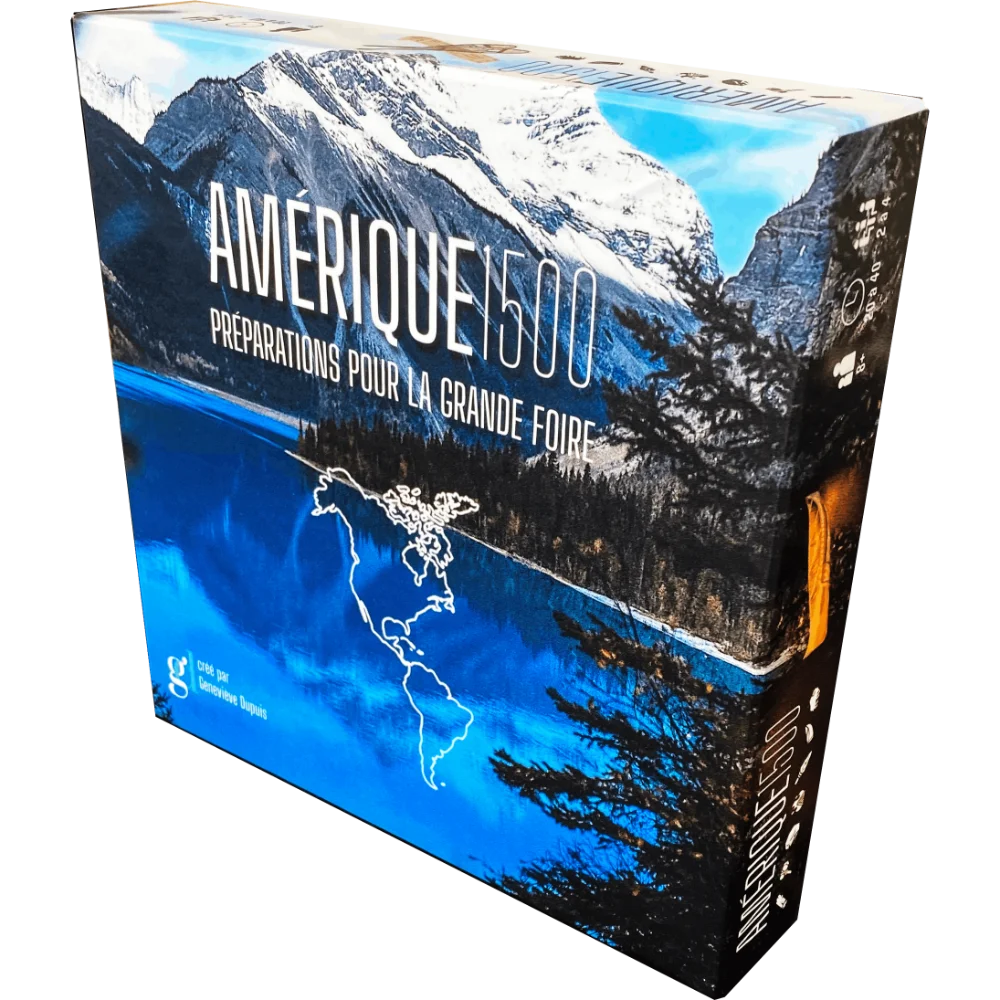Amérique 1500
2 to 4 players | Ages 8+ | 10 minutes / player
Overview
Amérique 1500 is a competitive game where each player must gather resources in order to be the first to complete 3 food requests. Each player chooses a different society and explores fauna and flora specific to their territory. Players must craft the right items to help them in their tasks of hunting, fishing, trading, or exploring.
A cooperative variant is also offered in the rulebook.

A Player’s Turn
There are 3 steps in a player’s turn:
- Roll the nature dice to determine the bonus to receive this turn.
- Choose one of the 4 available actions on the player board.
- Complete a task if you have the resources.
End of game
The game ends when a player has successfully completed three tasks.

Short video presentation (in French)
The rules
To print
These are the French rules for the “printed in Quebec” edition (square box).
To watch
Short presentation of the rules (in French)
Rules precision
- At the end of a round where one or more players have three discs on the tasks, if one player has more discs on the tasks than all other players, then that player wins the game.
Print and play + Review
A long time ago, there was a print and play version available on my website. You can still find it on this website with a review from the site owner.
To go deeper on the subject
Here is additional information on the concepts addressed in the game.
Iroquois
Food
The people of the Iroquoian languages mainly consume cultivated maize, beans, and squash, to which they add products from hunting, fishing, and gathering. Virginia deer meat is probably one of the most important, except in the north where moose is mostly consumed.
These people gather and eat various types of berries, nuts, tubers, and plants. Some tribes collect birch and maple sap. Men work on clearing forest areas, while women sow the land and harvest its fruits.
Housing
The longhouse is primarily a residence. It is believed that several families, consisting of between six and eight members, live in the same house. Before 1300, longhouses housed between 20 and 30 people. Later, they doubled in size and accommodated up to 100 people. It is likely that people living under the same roof are all relatives or connected to each other maternally, given that Iroquoian societies, such as the Haudenosaunee, are primarily matrilineal. For example, following the union of a couple, the man moves into his wife’s longhouse.
Men construct longhouses by burying rigid wooden beams into the ground. Flexible wooden poles are then attached to the top of the beams and bent to form the roof supports. Connected together using natural materials such as long strips of bark or bark rope, these horizontal poles solidify the frame. The structure is covered with wooden cladding.
Inside, sleeping platforms extend along the length of the house. There are usually between four and twelve fireplaces in a longhouse. The fireplaces are six to thirteen metres apart and are aligned in the centre of the structure. Two families share one fireplace. Ventilation holes in the roof prevent smoke from the fireplaces from swirling inside the house.
Transportation
The Iroquois mainly move on land or in birchbark or elm bark canoes.
Source: The Canadian Encyclopedia
Algonquins
Food
Algonquin peoples mainly feed on hunted and fished products. They hunt deer, bears, moose, caribou, and even seals, porpoises, and whales in certain regions. They use bows, arrows, spears, traps, snares, and clubs for hunting, and hooks, nets, spears, and nets for fishing. Meat is boiled or roasted for immediate consumption, or smoked and dried for preservation.
In the Great Lakes region, Algonquian peoples also collect maple or birch sap in early spring.
Housing
The routine of seasonal activities does not lead to a strictly sedentary way of life among the Algonquins. The dwellings are smaller and more temporary than those of the Iroquoians, ranging from birch bark tipis of a conical shape to dome-shaped wigwams or rectangular structures that house several families.)
Wigwams were cone-shaped (or dome-shaped in some subarctic indigenous people) and were usually made of wood. Animal skins were sometimes used to cover the walls of the structure. Wigwams were designed to be easily dismantled and assembled. These shelters could generally accommodate up to 10 to 12 people.
Inside, the floor of the wigwam was covered with tree branches and blankets made of animal skins, making the surface comfortable enough to sleep on. In the centre of the wigwam was the hearth, where family members would gather in a circle to cook, eat, and discuss their day. The smoke from the fire would escape through an opening left at the top of the wigwam.
Transportation
The Algonquins make narrow and slender birchbark canoes. In winter, they use snowshoes, sleds, and toboggans. Trade and visits seem to be common practices among neighbouring Algonquian tribes. The Algonquins also engage in bartering with the Iroquoian peoples, importing maize and fishing nets from the Wendats.
Source: The Canadian Encyclopedia
Incas
Food
Agriculture is important to the Incas. Potatoes and corn are staple foods. They also cultivate tomatoes, beans, chili peppers, and peanuts.
The Incas raise llamas and alpacas for their wool, which is used to weave most of their clothing. Their hides are used to make leather and craft sandals and bags. Additionally, their bones are used to make needles for weaving clothes. The Incas rarely eat llama or alpaca meat. Instead, they raise guinea pigs and ducks for food.
Incas living near the sea often consume fish.
Housing
Housing The Incas built stone houses. These houses consisted of four brick walls, a roof made of bamboo or straw, and only one door and a few windows. With their thick brick walls, the temperature inside the house remained fairly constant even when the outside temperature varied greatly.
Transportation
The Incas developed an impressive road network to facilitate transportation throughout the empire. It is estimated that this network measured approximately 20,000 kilometres (about 5 times the length of Canada). These roads were paved with stones and were used for transporting goods on foot or by llama.
To allow the roads to traverse challenging terrains such as mountains and swamps, the Incas built bridges and tunnels. The bridges were made of woven lianas. Wooden or bamboo slats formed the flooring.
Inuit
Food
Traditionally, the Inuit are nomadic gatherer hunters. The Inuit diet includes marine animals (seafood, whales, seals, sea lions and Arctic char), birds and land animals (ducks, ptarmigans, bird eggs, bears, muskoxen and caribou), as well as plants (roots and wild berries).
Housing
Historically, the Inuit used a simple tent called a tupiq when they travelled or hunted during the summer months.
While igloos provide shelter for Inuit families and hunters during the winter, the tupiq provides Inuit with a summer dwelling. The warm summers are an active time for hunting and fishing, which makes the community mobile. The portability of the tents allows the hunters to follow their prey. The tupiq is the perfect portable structure for these activities.
The tent coverings are sewn from sealskins, caribou hides, and other animals. The skins are supported by poles, which are often made from whale bones. The edges of the tupiq are weighted down with rocks. The fire pits, used for cooking and warmth, are located outside.
Transportation
Until modern times, the umiak (meaning “open skin vessel” in Inuktitut) was the primary means of transportation in the summer for the coastal Inuit. It could transport a family and their belongings to seasonal hunting areas and in whale hunting expeditions.
The kayak is a narrow hunting vessel made of sealskin stretched over a wooden or bone frame. The umiak, a larger vessel, is used for transporting people and supplies.
Measuring 6 to 10 metres in length and over 1.5 metres wide in the centre, the umiak can carry over 20 people. The frame is built with driftwood or whale bones, and it is all held together by leather thongs attached to wooden, antler, or ivory pegs. Bearded seal skins, sewn in such a way that the seams are waterproof, are then stretched over the frame and left to dry in order to adhere well.
Source: The Canadian Encyclopedia
